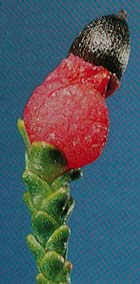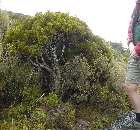Biography of Thomas Kirk
Reprinted in 2000 from BIOGRAPHIES - Dictionary of New Zealand Biography
KIRK, THOMAS - (1828-98) was born at Warwick, England, and educated at Coventry, and was employed for some years at Newark's timber mills in that town. He married (1850) Sarah, daughter of William Mattocks, of Coventry, and in 1863 he came to Auckland in the Gertrude.
In New Zealand he devoted himself at once to the study of botany. In 1867 he explored Great Barrier Island, in 1868 the east coast of north Auckland, in 1869 the Thames goldfield, in 1870 Waikato and in 1872 Rotorua and Taupo. He was for some years curator of the Museum and secretary of the Auckland Institute. In 1874 he was appointed lecturer in natural science at Wellington College (then affiliated with the University of New Zealand). He displayed a fine faculty for imparting knowledge, and it was a matter of regret when the relationship with the University ceased and he was appointed to the staff of Lincoln Agricultural College (1881). Kirk was elected a fellow of the Linnaean Society in 1871, was an original member of the Auckland Institute and a governor of the New Zealand Institute (1875-81 and 1887-88), and several times president of the Wellington Philosophical Society. In 1875 he published (in collaboration with J. Balfour) reports on the durability of New Zealand timbers, and thereafter was a constant contributor to the proceedings of the Linnaean Society, the Linnaean Society of New South Wales, Nature, the Journal of Botany and the Gardeners' Chronicle.
In 1885 Kirk became chief conservator of state forests, and he organised the Forestry department, which, however, was abolished as a measure of economy in 1888. In 1889 his Forest Flora of New Zealand was published by the Government. After retiring he made further explorations. notably in Stewart, Auckland and Campbell islands, the Antipodes and the Snares. At the time of his death he had made good progress with his magnum opus, The Students' Flora of New Zealand and Outlying Islands, which was completed by T. F. Cheeseman and published in 1899. It was said of Kirk that no other botanist ever acquired such a complete familiarity with the flora of New Zealand. Besides his books he contributed 122 botanical papers to the Transactions of the New Zealand Institute.
Kirk was a staunch Baptist, and was president of the New Zealand Baptist union (1892). He died on 1898.03.08.
Sources: Kirk, op. cit.; Trans. N.Z. Institute, vol 31, et pass.; Cheeseman, Manual of N.Z. Flora; Australian Association for the Advancement of Science, 1891; Leckie (p); Otago Daily Times, 1898.05.10; Evening Post, 1898.03.09.
This page was last updated on: 1999.11.07 - © Copyright the Kirk Society.
Some of Kirk's published work is available online. The following conifer works are of interest; several contain his drawings of new species:
Kirk, T. 1877. On the New Zealand Species of Phyllocladus. Transactions and Proceedings of the Royal Society of New Zealand 10:378-383 (accessed 2011.03.27).
Kirk, T. 1877. A revised Arrangement of the New Zealand Species of Dacrydium, with Descriptions of new Species. Transactions and Proceedings of the Royal Society of New Zealand 10:383-391 (accessed 2011.03.27).
Kirk, T. 1883. Description of a new Pine. Transactions and Proceedings of the Royal Society of New Zealand 16:370-371 (Podocarpus acutifolius) (accessed 2011.03.27).




